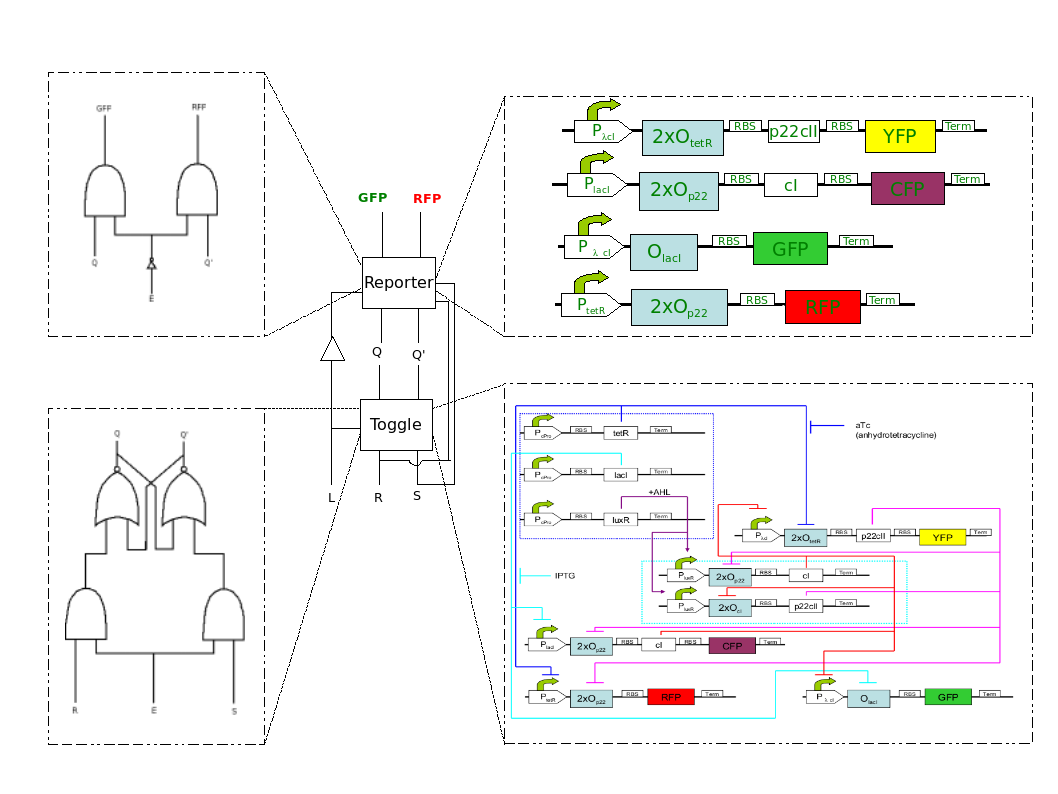ETHZ/Wiki rel
From 2007.igem.org

.:: Introduction ::.
It is the third time the [http://www.ethz.ch ETH Zurich] takes part in International Genetically Engineered Machine Competition (iGEM). This year, our combined team of biologists and engineers has undertaken the task of educating E.coli ! More specifically, in our project (Fig. 1)
we are trying to create E.coli which have the ability to distinguish between chemicals they are exposed to after they have undergone a training phase.Stay in this page for an overview of how EducatETHE.coli works, the motivation behind it and its possible future applications. If you want to see the biological design of our system and the parts that it consists of, or if you are interested in building it yourself and want to read the lab protocols, the Biology Perspective will be of interest to you. If you want to know more on how EducatETH E.coli has been modeled and simulated, or on its equivalences to systems such as flip-flops and finite state machines, please visit the Engineering Perspective. You may also want to visit Meet the Team for information regarding the team and Pictures! for our photo gallery. Finally, in Team Notes you can read the notes exchanged by the team during preparation for the competition.
.:: Team Members ::.
As iGEM is a synthetic biology competition, the ETH Zurich team consists of balanced numbers of biology and engineering students. Our team members are:
- Project advisors: Sven Panke, Joerg Stelling
- Undergraduate students: Martin Brutsche, Katerina Dikaiou, Raphael Guebeli, Sylke Hoehnel, Nan Li, Stefan Luzi
- Graduate students: [http://christos.bergeles.net Christos Bergeles], [http://www.tik.ee.ethz.ch/~sop/people/thohm/ Tim Hohm], [http://fm-eth.ethz.ch/eth/peoplefinder/FMPro?-db=phonebook.fp5&-format=pf%5fdetail%5fde.html&-lay=html&-op=cn&Typ=Staff&Suche%5fText=kemmer&Suche%5fText%5fpre=kemmer&-recid=3772770936&-find=/ Christian Kemmer], Joseph Knight, Markus Uhr, [http://www.ricomoeckel.de Rico Möckel]
For more information on the team members, follow the links or visit Meet the Team.
.:: Motivation ::.
Learning plays a major role for living organisms, as it enables them to survive by adapting to an ever-changing environment. Engineering a simple biological system which exhibits learning behavior is of great interest, as it can support our understanding of this procedure by comparison with natural systems. On the other hand, learning and memorizing plays an equally big role in engineering; from handwriting recognition on PDAs to plain logical circuits storing their binary state on computers, it can be found on numerous everyday life applications. Constructing a biological analogue of a simple memory as known from logic design can hopefully function as a biological building block from which more complex systems may be constructed. We therefore think that EducatETH E.coli operates on an exciting interface between engineering and biology.
.:: E.coli Intelligence (E.I) ::.
How can we make E. Coli bacteria able to report us about their environment? Can we teach bacteria to recognize a specific chemical?
Based on these questions we set forth to designing biological circuits to educate E. Coli cells, and to improve the E. Coli Intelligence...Our goal is to design an E.coli strain, able to distinguish between two chemical substances after an assigned learning process. The learning process is induced by an external chemical signal (teaching substance). Afterwards, the bacterial strain will be taken to a testing phase, where the output will be in either green or red fluorescence, depending on whether the bacteria recognized the same chemical substance in the testing phase as it was trained in the learning phase or a different one.
In order to come to this idea for implementation, we had a discussion based on ideas from Logic Design. A toggle that keeps it state, can be a JK flip-flop with a latch. Reporting circuits can be constructing using AND gates, where the inputs are the chemicals and the previous state of the JK flip-flop. In Fig.2, we present the blending of the engineering and biological perspective.
The toggle that our system contains is based on the toggle described in [1]. However, since we want two separate processes, we had to change appropriately the promoter sites. Hence, now, the presence of two chemicals is required for the toggle to function. This allows us to distinguish between the states of learning and recognition. At the first state, due to the learning protein HSL, the toggle is active, and reaches a steady state based on the different input chemicals. At the second state, the reporters are activated, and fluorescent protein is produced based on the newly added chemical, and the former steady state of the toggle. The newly added chemical doesn't affect the toggle, since the learning protein HSL is abscent. In the final system, we have added two more reporters, in order to check which chemical the system is currently learning. These promoters are active both during the learning, and the recognition process.
.:: References ::.
[1]: Toggle Switch
.:: Acknowledgements ::.
[http://europa.eu The European Union]
[http://www.ethz.ch The ETH Zurich]
[http://www.geneart.com GENEART]
.:: Links ::.
.:: To Do ::.
- Need picture: Bacteria red, Bacteria Green, two pictures showing different exposure to chemicals (Sylke: see my presentation Sven will hold for me tonight (20.09) -> the FACS guy wants probes of our XFP expressing E.coli - the one who brings it to him can just put it under the microscope and take a few pictures for the wiki)
- Need picture: Einstein ecoli (Sylke: does Stefan have the layer file?)
- Stupidity: All E. Colis are equal, but our E. Colis are more equal than the others :D
- Katerina: 2. If we have a separate "Meet the team" page (which is good that we have), we have to make sure that all data about each one of us (short bio+photo) appear also on each one's user page-the same version would be the best, in my opinion.
- Katerina: 3. Figure 2, bottom right part needs to be a bit larger/more clear, in my opinion, as it's important. (Christos: If you click, then it becomes larger. Will have the same at the bio part as well... Should I make it bigger anyway? I will change it, it is wrong anyway :D)

